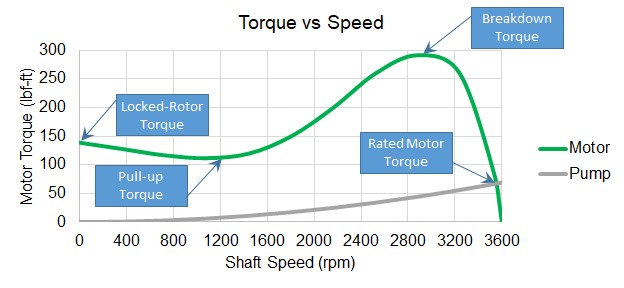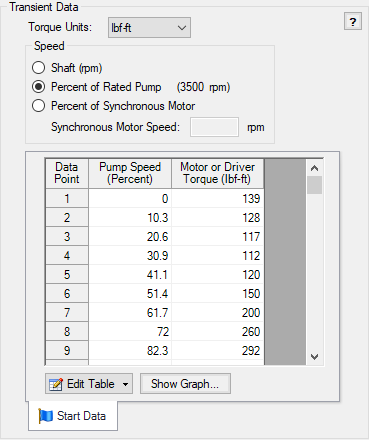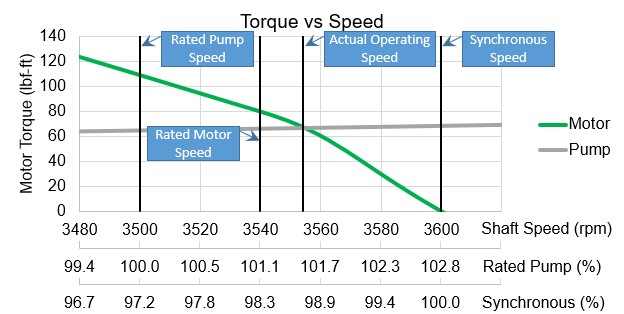Startup with Inertia
The Startup with Inertia transient is the first of two inertial transients that can be defined for the Centrifugal (Rotodynamic) Pump. Modeling an inertial pump startup simulates a pump which is connected to a motor that is initially supplying no torque, and is suddenly switched on. The inertial startup is an uncontrolled start - meaning the torque characteristics of the motor alone will drive the speed change behavior. The inertial startup does not capture a controlled start, where there may be complex equipment such as a PID-controlled VFD slowing down the startup of the pump, and cannot be used in combination with the Variable Speed Controlled Setpoint options for a pump.
Inertial Characteristics
The total rotating inertia of the pump/motor system must be available. This must include all rotating components - the motor rotor, shaft, impeller, entrained liquid, and any other connected components. This value can be estimated or directly specified.
Transient Data
To solve the torque balance equations, the torque on the shaft at any given speed must be known. The torque exerted by the pump on the shaft (that is, from the fluid) can be determined with the Standard Pump Curve power curve. The torque characteristics of the device driving the pump must be defined by the user. Typically, this is an induction motor. It could also be a synchronous motor, a DC motor, or another device entirely such as a shaft-connected turbine or diesel engine.
Induction motors generally follow one of a few standard torque vs speed profiles. Shown below is torque profile of a motor showing typical NEMA Design B characteristics. Also shown is the torque behavior of the pump, as determined with the affinity laws.
Note: The pump torque characteristics can be considered ideal for the user defined power curve. A real pump will have higher torque during startup due to friction and other startup effects. These are not represented here, as including them would make the model and required input much more complicated for little benefit.

Figure 1: A typical NEMA Design B motor torque curve and ideal pump torque curve.
AFT Impulse allows the definition of the Motor or Driver Torque curve vs. relative or absolute speeds.

Figure 2: Motor or Driver Torque curve entered as Percent of Rated Pump Speed vs Torque.
It is important to note that Rated Pump Speed, Rated Motor Speed, and Synchronous Motor Speed are different values. If the motor is perfectly matched to the pump, the two rated speeds may be the same. If entering the data as Shaft Speed (rpm), then no concern over a rated speed is required. However, they are important for relative (%) data entry.
To clarify the difference between these options consider the following values (which correspond to Figure 1):
-
Rated Pump Speed - 3500 rpm - Rated by the pump manufacturer
-
Rated Motor Speed - 3540 rpm - Rated by the motor manufacturer, the speed at which the motor is designed to handle its rated torque
-
Synchronous Motor Speed - 3600 rpm - A characteristic of most electric motors - the speed at which the electrical field rotates. Available from the motor manufacturer, and often the torque characteristics are plotted against percent of synchronous speed.

Figure 3: Various speeds for the Figure 1 characteristics. Note that the corresponding torque value for 100% Synchronous and 100% Rated Pump are different.
Of interest in Figure 3 is that not only are there three different commonly referenced speed references, when placed into a system the actual operating speed is not any of these values! Why is this? The actual operating point depends on how well matched the motor is to the pump and its operating point. In this instance, the motor is providing enough torque that the rated pump speed is exceeded. Additionally, the system is configured in such a way that the resistive torque is lower than the motor's rated torque at rated motor speed. This causes the motor to speed up further until the pump torque and motor torque match.
Special Condition
The pump will need to have its special condition set to Pump Off With Flow Through to model a Startup.



